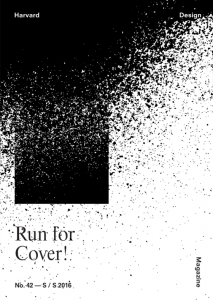 More mailbag stuff! — This one arrived last week: Harvard Design Magazine no. 42: Run for Cover!
More mailbag stuff! — This one arrived last week: Harvard Design Magazine no. 42: Run for Cover!
In this issue, Demilit (of which I’m a member) has a piece on “thinking with suspicious packages,” an intervention into the discourse around tactical and informal urbanism(s). It draws from our research on urban securitization and electronic networks, particularly by using walking methods to intimately sense the city.
The piece begins:
Report suspicious activity. If you see something, say something. Do not leave bags unattended. These are the instructions for acceptable cohabitation in the secure city. But objects mediate between bodies. People are allowed to put materials into new and unexpected configurations, as long as such arrangements do not inspire fear or dread.
Objects in space must have an author or an owner who speaks for them, lest they leave interpretation up to undue speculation. Unknowability is insecurity.1 However, the alarmist idea of the “suspicious package” may unlock a different politics of urban life, one premised on sensuous materialism rather than security theater.2
Suspicious packages, or “suspacks,” as we have started to refer to them, are perplexing.3 They are material things that inspire dark thoughts in urban subjects, far surpassing what can be deduced from their ordinary thingness. Suspended in a state of possibility, suspacks flood the synapses with mental triggers like few other creations can. In other words, the suspack is matter in semiotic flux. A suspack is not (yet) a bomb or weaponized debris in motion, but neither is it a plain box. If it were a bomb, we would call it a bomb. If it were poison, we would label it with warnings. If it were a delivery, it would belong somewhere else—on a truck en route to its destination, say. But sometimes (most of the time, in fact), a box is just a box and an unattended suitcase is simply luggage that was misplaced. Suspacks are a little-understood entity—not quite a fixed category or a marketable commodity—that defies the certitudes of designed products.
The entire piece is up at the HDM website, along with many other excellent pieces. Our big thanks to editors Jennifer Sigler and Leah Whitman-Salkin for their careful work, and to the staff who handled corrections and bios. We’re continuing to expand this investigation into the suspicious package (and I gave a recent panel talk on this at the Regional Studies Assoc, North America conference).